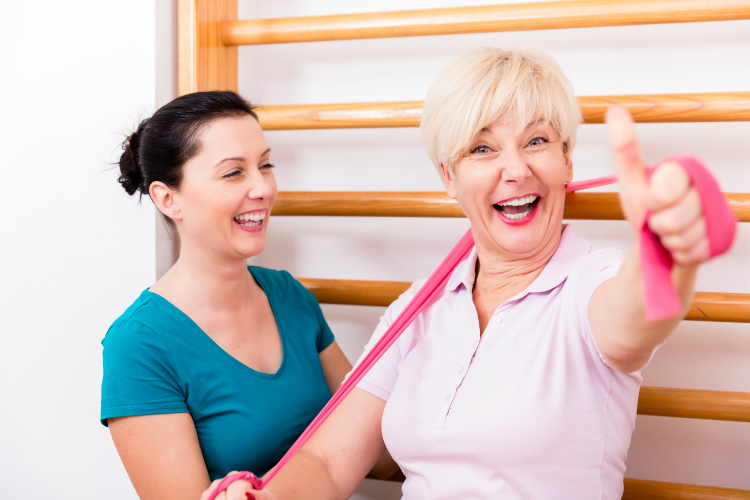You reach for the railing. The stairs aren’t steep — they’re familiar — but your foot hesitates. Your balance doesn’t feel like yours anymore.
This is what stroke recovery can feel like. Not dramatic. Just different. Off.
And that difference makes everyday moments feel uncertain. Getting out of a chair. Turning your head. Lifting a bag. These aren’t “goals” on a rehab worksheet — they’re your life. That’s why we treat every stroke recovery plan as a fresh conversation. A new blueprint. A return to control.
>>>Request your appointment and start your personalized recovery plan and take back movement with meaning.
Recovery Isn’t About “Bouncing Back.” It’s About Rebuilding Forward.
A stroke doesn’t just disrupt physical movement — it interrupts the brain’s connection to the body. That’s why the recovery process isn’t linear or predictable. It’s layered. Physical. Mental. Emotional.
Some patients we work with in Harlem come in after months of progress, only to hit a wall. Others in Morningside Heights are just starting their journey and feel overwhelmed by the unknowns. Both are in the right place.
We don’t just ask “What can you do?” We ask “What do you want to do again?”
Reconnecting the Brain and Body: Where We Begin
There’s no one-size-fits-all approach to stroke recovery, but there are foundational skills we focus on early in care. At this stage, our goal is to reestablish body awareness, movement patterns, and a sense of control — not just in muscle, but in how the body relates to space, balance, and effort.
We often start with sensory feedback techniques to help patients reconnect to their affected limbs. Gentle manual mobility work reduces stiffness or spasticity that may be limiting motion. Core and trunk stability training helps reintroduce posture and balance, especially during sit-to-stand or walking exercises. As strength returns, we carefully layer in resistance to encourage activation without overwhelming the nervous system.
Every part of this process is about restoring motion with meaning — so our patients feel not just stronger, but safer in their bodies.
What Innovation Feels Like in Real Recovery
We use technology not to impress — but to empower. Innovation in stroke rehab should feel accessible, personalized, and effective.
That’s why our team integrates advanced techniques such as:
- NEUBIE Therapy, which reactivates neuromuscular pathways with direct current and helps build movement where there was none
- Manual Therapy and Active Release Technique (ART) to reduce restrictions, improve mobility, and allow smoother joint motion
- Pilates for Rehab to gently rebuild postural control and core stability, especially helpful for asymmetrical strength recovery
- Cupping Therapy and Low-Level Laser Therapy for circulation, pain relief, and tissue healing
- Heart Rate Variability (HRV) monitoring to track stress levels and ensure a recovery pace that’s both effective and sustainable
This blend of high-tech tools and hands-on expertise is what allows us to move beyond basic rehab — and into real transformation.
Your Progress Is Measured in Moments, Not Milestones
No two patients make progress in the same way.
One person may celebrate standing from a chair without using their arms. Another might regain the ability to hold a pen. For someone else, it's walking across the room without fear. These aren’t clinical milestones. They’re personal victories.
We’ve seen stroke survivors regain the ability to garden. Ride the train alone. Dance at their daughter’s wedding.
Progress isn’t a graph — it’s a return to yourself.
When Is the Right Time to Begin Stroke Therapy?
It’s never too early — and never too late — to improve movement after a stroke. Some of our patients start rehab just days after a hospital discharge. Others come to us years later, still feeling stuck or unsure.
You might benefit from stroke rehab if you:
- Struggle to trust your balance or coordination
- Avoid using one side of your body
- Feel stiff, weak, or disconnected in movement
- Have lost confidence in navigating daily life
If you’ve plateaued in another setting, we can help you break through.
Why Your Environment Matters
Physical therapy works best when it fits your life — not the other way around.
That’s why we offer care in two unique locations across Upper Manhattan. Our Harlem clinic supports working adults and older adults alike with personalized attention and flexible scheduling. Our Morningside Heights location serves Columbia students, faculty, and neighbors navigating fast-paced routines and academic pressures.
Wherever you are in your recovery, you’ll find a space that respects your pace, your goals, and your story.
Step Into a New Chapter of Recovery
A stroke may have interrupted your path — but it doesn’t define it. With the right care, the right tools, and the right people in your corner, your body can regain strength. Your brain can create new patterns. And your life can open back up.
Let’s build a plan that moves with you — not against you. One step at a time.
Call us at 212-222-6525 or request your appointment online. If you're in Harlem or Morningside Heights, we're here to help you rediscover your movement — and your momentum.







